Zoom
Trash

The storytime usually incorporates the five senses throughout the session.
This curation has a great list of resources for librarians interested in including sensory storytime in the weekly program schedule.
Storytime for the Spectrum. Librarian Carrie Rogers-Whitehead noticed there were always a couple of kids running around and making noise during one of her storytimes.
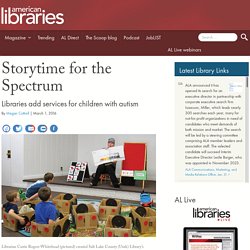
And when they started up, the rest of the 2- and 3-year-olds followed suit. She decided to ask their mom what she could do to make storytime a more positive experience for her kids, but she didn’t expect the mother’s response. “She began crying and got very upset. She said, ‘I’m so sorry. They have autism. Programming for Children with Special Needs, Part One - ALSC Blog. By Tricia Bohanon Twarogowski With budgetary and staffing issues currently facing libraries, children’s programming managers and staff may wonder, “Why begin a new storytime program for children with special needs and their families?”
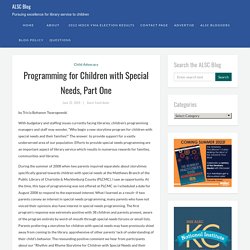
The answer: to provide support for a vastly underserved area of our population. Efforts to provide special needs programming are an important aspect of library service which results in numerous rewards for families, communities and libraries. During the summer of 2008 when two parents inquired separately about storytimes specifically geared towards children with special needs at the Matthews Branch of the Public Library of Charlotte & Mecklenburg County (PLCMC), I saw an opportunity. Programming for Children with Special Needs, Part Two - ALSC Blog. Programming for Children with Special Needs, Part Three - ALSC Blog. Programming for Children with Special Needs, Part Four - ALSC Blog. By Tricia Bohanon Twarogowski Last week in Part Three, I shared program plans from past Rhythm and Rhyme storytimes for children with special needs and their families.
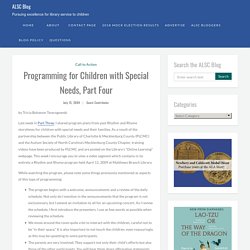
As a result of the partnership between the Public Library of Charlotte & Mecklenburg County (PLCMC) and the Autism Society of North Carolina’s Mecklenburg County Chapter, training videos have been produced by PLCMC and are posted on the Library’s “Online Learning” webpage. This week I encourage you to view a video segment which contains in its entirety a Rhythm and Rhyme program held April 11, 2009 at Matthews Branch Library. While watching the program, please note some things previously mentioned as aspects of this type of programming: The program begins with a welcome, announcements and a review of the daily schedule.
The second video featured on this PLCMC “Online Learning” webpage shows the Rhythm and Rhyme program in action: After this taping, we changed how we set up materials for the class. Programming for Children with Special Needs, Part Five - ALSC Blog. By Tricia Bohanon Twarogowski In this final installment of the series examining programs for children with special needs and their families, I share ideas on two final topics: potential partnerships and future possibilities for this specialized programming.

Partnerships As mentioned in Part One, reaching out to community organizations affiliated with special needs is beneficial not only to attract participants but also to gain feedback in both the planning and assessment of programming. Partnerships will be influenced by proximity, quality of contacts made and their willingness to support your efforts. To locate potential partners, ask parents who attend your programs for ideas. Reading the local newspaper may provide leads regarding collaborative efforts. Libraries and Autism: We're Connected. Sensory Storytime Tips - ALSC Blog. I’ve been doing my Sensory Storytime for 3 years now.
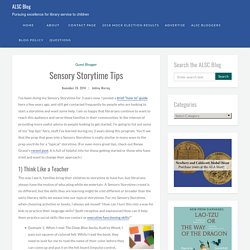
I posted a brief “how-to” guide here a few years ago, and still get contacted frequently by people who are looking to start a storytime and want some help. I am so happy that librarians continue to want to reach this audience and serve these families in their communities. In the interest of providing more useful advice to people looking to get started, I’m going to list out some of my “top tips” here, stuff I’ve learned during my 3 years doing this program. You’ll see that the prep that goes into a Sensory Storytime is really similar in many ways to the prep you’d do for a “typical” storytime.
(For even more great tips, check out Renee Grassi’s recent post. 1) Think Like a Teacher The way I see it, families bring their children to storytime to have fun, but librarians always have the motive of educating while we entertain. Example 1: When I read The Deep Blue Sea by Audrey Wood, I pass out squares of colored felt. Too Many Choices! Books to Read During Sensory Storytimes - ALSC Blog. How do you select the right picture book to read to an audience of children with special needs?
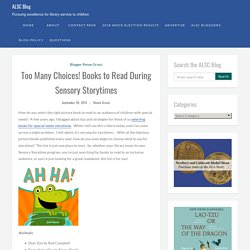
A few years ago, I blogged about tips and strategies for those of us selecting books for special needs storytimes. While I still use this criteria today, now I’ve come across a slight problem. I will admit, it’s not exactly a problem… With all the fabulous picture books published every year, how do you even begin to choose what to use for storytime? This list is just one place to start. So, whether your library hosts its own Sensory Storytime program, you’re just searching for books to read to an inclusive audience, or you’re just looking for a great readaloud, this list is for you! Animals Dear Zoo by Rod CampbellDog’s Noisy Day by Emma DoddJump! Colors Dog’s Colorful Day by Emma DoddWow! Selecting Books for Special Needs Storytimes - ALSC Blog. Whether or not you have led a special needs program before, the fact is that you may have already led one and not even known it.

If your storytimes are drop-in and you don’t have information about a child’s special need ahead of time, selecting crowd-pleasing stories could be a challenge. So, in order to be prepared, plan ahead and ask yourself these questions: Is the book based on children’s experiences and interests? If a child can identify with something in the story, it becomes easier for them to understand and enjoy. With this in mind, I focus my story selections around a particular theme. Beloit Public Library offers ‘Sensory Storytime' for children with special needs. Tips on Storytimes for Children with Special Needs.
SNAILS Sensory Storytime Demonstration. Sensory Story Time: A program designed for families of children with autism. Conducting a Storytime for Children with Special Needs. Everyday Games for Sensory Processing Disorder: 100 Playful Activities to Empower Children with Sensory Differences eBook: Barbara Sher: Kindle Store. Sensory Yoga for Kids: Therapeutic Movement for Children of all Abilities by Britt Collins, Paperback. Pediatric Occupational Therapist, Britt Collins, graduated from Colorado State University over 10 years ago and since then has worked tirelessly on OT and Sensory Integration awareness, research and application.
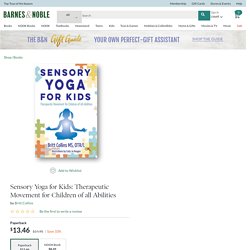
Britt has worked in a variety of settings including pediatric hospital inpatient, ICU, rehabilitation, outpatient clinics, homes, schools and skilled nursing facilities. Buy A Teacher's Guide to Sensory Processing Disorders 2 CD set at S&S Worldwide. Research shows that 20% of all school-age children in the U.S. have problems with sensory integration.
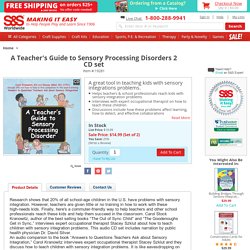
However, teachers are given little or no training in how to work with these high-needs kids. Finally, here's a commuter-friendly way to help teachers and other school professionals reach these kids and help them succeed in the classroom. Carol Stock Kranowitz, author of the best selling books “The Out of Sync Child” and “The Goodenoughs Get in Sync,” interviews expert occupational therapist Stacey Szklut about how to teach children with sensory integration problems. This audio CD set includes narration by public health physician Dr. Sensory rooms help calm children at school. When Deb Bearman knows her son, Kyle, is going to have a bad day, she calls ahead to his teacher at Heritage Elementary.

Once at Heritage, the 10-year-old fourth-grader, diagnosed with cerebral palsy at 9 months, may get a hug and a quick visit to the sensory room. "He uses it a lot in the morning when he first gets there," Bearman said. His favorite calming tool is the bubble light, a floor to ceiling tube that changes colors. Sensory rooms, once the domain of special-needs students, particularly children diagnosed with autism and Asperger’s syndrome, are going mainstream. Through the use of objects like lights, rocking chairs, pressure mats, thick elastic bands and wet sand, sensory rooms can calm a child to focus on school. Vla kaleidoscope sensory storytimes books handout renee edwards. Special Education Software, Curriculum & Learning Tools. About Us - Boardmaker. One of the earliest companies in the Assistive Technology field was Mayer-Johnson, which started as a mail order company focusing on augmentative communication products. Roxie Johnson, co-owner of the company with her husband Terry, had been working as a speech therapist with special needs children in the public-school system and with adults in a hospital setting.
She saw the need for a set of picture symbols that limited-speaking or non-speaking persons could use for communicating. She developed the first book entitled The Picture Communication Symbols (PCS) that included 700 picture symbols. The symbols were designed with thick lines, so they could be photocopied to support multiple users. Center for Literacy and Disability Studies. We are currently updating the Writing With Alternative Pencils CD because the original featured software and hardware solutions are no longer available. While we do our work, please see options you can download free-of-charge from our Dynamic Learning Maps Professional Development Website.
(The available pencils can be found here, under the Writing Resources tab). (Created by The Center for Literacy & Disability Studies, UNC-Chapel Hill) Writing is undeniably an essential component of literacy instruction for students without disabilities. Without question it is a part of their daily instruction. What Is A Social Story? - Carol Gray - Social Stories. Social stories and comic strips - National Autistic Society. Social storiesTM and comic strip conversations can help autistic people develop greater social understanding and stay safe.
Find out about social stories, how to use them, and how to write your own. Find out about comic strip conversations, how to use them, and how to make your own. What are social stories? Social storiesTM were created by Carol Gray in 1991. They are short descriptions of a particular situation, event or activity, which include specific information about what to expect in that situation and why. Paul V. Sherlock Center on Disabilities. Intro to Adapted Books. Adapted Books in Autism Units. Everything You Need To Know About Activity Schedules - Special. Activity schedules are meant to help people understand and manage the daily events in their lives. Get Them Talking: Communication Boards for Toddlers and Preschoolers. Traditionally much of the language offered to young and beginning Augmentative and Alternative Communication (ACC) communicators has been comprised of nouns and descriptive words.